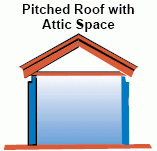
Attic/roof insulation
Up to 30% of the heat produced in your home may be escaping through your roof if it is un-insulated. Even if you already have insulation in your roof, you may still be losing heat if it is not up to the level specified in the most recent Building Regulations. You may want to replace it with a higher-performance insulation material.
Pitched roof insulation with an attic space
If you have a pitched roof with an attic space, one of the simplest ceiling insulation methods is to lay a quilt (Mineral Fibre,
Glass Fibre, Hemp, Sheepswool materials). If this type of material is to be used, it is important to ensure that the quilt is
installed in two layers and in two directions in order to ensure the maximum benefit is achieved. There are many other
products that can insulate effectively at ceiling level like shredded glass fibre, mineral fibre or cellulose fibre blown into
the attic between and above ceiling joists.
After the attic is insulated at joist level, its temperature is reduced, and it is required to insulate the water storage tank and pipes. The water storage tank can be insulated with any semi-rigid insulating board and the pipes with closed cell neoprene, polyethylene, glass fibre and mineral fibre in pipe section form.
Homeowners availing of insulation at horizontal ceiling level grants under the Home Energy Savings scheme should aim to achieve a U-value of 0.13 W/m K or better (i.e. lower).
Conversion to an insulated attic room
When converting your attic into a room, insulation is placed in between the rafters. The insulation can be semi-rigid
insulation boards such as expanded polystyrene board, extruded polystyrene board, glass fibre batts, mineral fibre
batts, urethane foam board or phenolic foam boards. Some contractors also offer a spray-on cellulose fibre or
polyurethane foam insulation system between rafters. If a first layer of insulation is placed between rafters, a second,
thin layer applied to the underside of the rafters avoids thermal bridging. Glass fibre quilt and mineral fibre quilt can
also be used. A vapour check should be installed on the warm side of the insulation and ventilation above.
These materials can be held in place by a plaster lining board across the underside of the rafters to minimise heat loss and provide the necessary fire protection. Lining boards can have integral insulation backings, such as glass-fibre-backed insulated plaster and urethane-foambacked insulated plasterboard, often lined with aluminium foil.
Homeowners availing of attic insulation of a pitched roof or on slope level grants under the Home Energy Savings scheme should aim to achieve a U-value of 0.20 W/m K or better (i.e. lower).
Flat roof insulation
The type of insulation used in new flat roofs is dependent on the roof structure. On a new concrete slab, with a screed, semi-rigid insulation boards such as expanded polystyrene board, extruded polystyrene board, glass fibre batts, mineral fibre batts, urethane foam board or phenolic foam board are laid under the roof covering. In a new timber structure, glass fibre quilt and mineral fibre quilt can be laid between the joists.
INGLOTHERM LTD is specialised in installation of special Neotherm 150mm high density expanded polystyrene boards with embedded felt for external use with another good quality felt layer. This solution is very convenient for clients that want to insulate their flat roof extensions without big hassle and in relative quick time (1-2 days).
Homeowners availing of flat roof insulation grants under the Home Energy Savings scheme should aim to achieve a U-value of 0.22 W/m K or better (i.e. lower).
Please visit our attic and roof insulation works gallery for better understanding this technology.
Based on materials from Sustainable Energy Ireland website
If you want to arrange a free survey at your home and get the quote for attic or roof insulation, please contact us.

